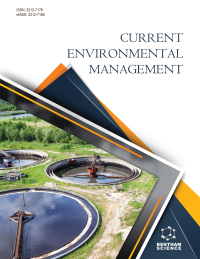- Home
- A-Z Publications
- Current Environmental Management (Formerly: Current Environmental Engineering)
- Issue Home
Current Environmental Management (Formerly: Current Environmental Engineering) - Current Issue
Volume 7, Issue 1, 2020
-
-
A Mini Review of Technological Options for Disposal of Municipal Solid Waste in India
More LessAuthors: Ravindra Verma and Prakash S. BisenBackground: It has been seen that 90% of municipal solid waste is disposed off in open dumps and landfill sites, causing problems for the environment, and public health in developing countries. Many technological options can convert waste into various forms of energy. Heat and electricity can be generated and utilized for specific thermodynamic conversion processes and different types of biofuel can also be extr Read More
-
-
-
A Backward Scenario Planning Overview of the Greenhouse Gas Emission in Iran by the End of the Sixth Progress Plan
More LessAuthors: Nima Norouzi and Mohammad A. DehghaniTaking Iran as the 7th Greenhouse Gas (GHG) emission source of the world, the country contains a high potential for the emission management plans and studies. As the economy is a significant factor in the greenhouse gas emission, studying the economy and GHG emission integrated relations must be taken into account of every climate change and environmental management plan. This paper investigates the relation Read More
-
-
-
Natural Resources for Sustainable Water Treatment - A Review
More LessAuthors: Manoj K. Karnena and Vara SarithaBackground: Purification and remediation of water remain to be a mammoth challenge for environmental engineers, continuously mounting pressure on providing safe water for consumers. Nevertheless, care has to be taken to avoid chemicals in treatment, which could prove to be toxic. One of the most prominent stages in treating water for human consumption is clarification through coagulation and flocculation to remo Read More
-
-
-
The Growth of Triticale (Triticosecale wittm.) in Multi-Metal Contaminated Soils by Use of Zeolite: A Pilot Plant Study
More LessBackground: Heavy metals are the most common form of environmental pollution and the evaluation of heavy metal contaminated soils is necessary for reducing the associated risks, making the land resource available for agricultural production, and enhancing food security. There are 2,000 contaminated sites in Greece, according to a previous survey report issued by the Greek Ministry of Environment, out of which 30 Read More
-
-
-
Effects of Fine Grid NO2 Modeling around a Thermal Power Station: A Case Study
More LessAuthors: Md M. Karim, Navin Bindra and Mohammed MukteruzzamanObjective: The objective of this study was to assess the outcome of fine grid modeling on top of a courser grid to predict the NO2 concentration more accurately in an airshed and at sensitive receptors. Methods: This study assessed the cumulative NO2 impact of all major emission sources in an airshed using USEPA regulatory model AERMOD. A 50 km by 50 km airshed is considered in the study. Micro-environmental pollution Read More
-
Volumes & issues
Most Read This Month Most Read RSS feed
Article
content/journals/cem
Journal
10
5
false
en


